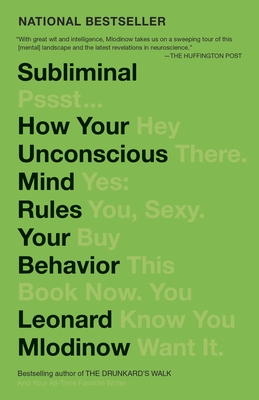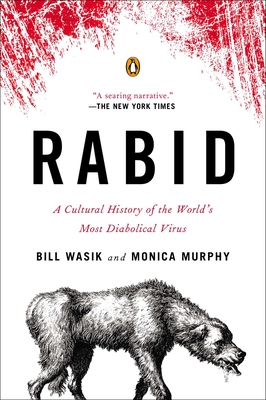Winner of the 2013 PEN/E.O. Wilson Literary Science Writing Award
Over the past two decades of neurological research, it has become increasingly clear that the way we experience the world--our perception, behavior, memory, and social judgment--is largely driven by the mind's subliminal processes and not by the conscious ones, as we have long believed. As in the bestselling The Drunkard’s Walk: How Randomness Rules Our Lives, Leonard Mlodinow employs his signature concise, accessible explanations of the most obscure scientific subjects to unravel the complexities of the subliminal mind. In the process he shows the many ways it influences how we misperceive our relationships with family, friends, and business associates; how we misunderstand the reasons for our investment decisions; and how we misremember important events--along the way, changing our view of ourselves and the world around us.
Over the past two decades of neurological research, it has become increasingly clear that the way we experience the world--our perception, behavior, memory, and social judgment--is largely driven by the mind's subliminal processes and not by the conscious ones, as we have long believed. As in the bestselling The Drunkard’s Walk: How Randomness Rules Our Lives, Leonard Mlodinow employs his signature concise, accessible explanations of the most obscure scientific subjects to unravel the complexities of the subliminal mind. In the process he shows the many ways it influences how we misperceive our relationships with family, friends, and business associates; how we misunderstand the reasons for our investment decisions; and how we misremember important events--along the way, changing our view of ourselves and the world around us.
The irresistible, ever-curious, and always best-selling Mary Roach returns with a new adventure to the invisible realm we carry around inside.
“America’s funniest science writer” (Washington Post) takes us down the hatch on an unforgettable tour. The alimentary canal is classic Mary Roach terrain: the questions explored in Gulp are as taboo, in their way, as the cadavers in Stiff and every bit as surreal as the universe of zero gravity explored in Packing for Mars. Why is crunchy food so appealing? Why is it so hard to find words for flavors and smells? Why doesn’t the stomach digest itself? How much can you eat before your stomach bursts? Can constipation kill you? Did it kill Elvis?
“America’s funniest science writer” (Washington Post) takes us down the hatch on an unforgettable tour. The alimentary canal is classic Mary Roach terrain: the questions explored in Gulp are as taboo, in their way, as the cadavers in Stiff and every bit as surreal as the universe of zero gravity explored in Packing for Mars. Why is crunchy food so appealing? Why is it so hard to find words for flavors and smells? Why doesn’t the stomach digest itself? How much can you eat before your stomach bursts? Can constipation kill you? Did it kill Elvis?
In Gulp we meet scientists who tackle the questions no one else thinks of—or has the courage to ask. We go on location to a pet-food taste-test lab, a fecal transplant, and into a live stomach to observe the fate of a meal. With Roach at our side, we travel the world, meeting murderers and mad scientists, Eskimos and exorcists (who have occasionally administered holy water rectally), rabbis and terrorists—who, it turns out, for practical reasons do not conceal bombs in their digestive tracts.
Like all of Roach’s books, Gulp is as much about human beings as it is about human bodies.
Like all of Roach’s books, Gulp is as much about human beings as it is about human bodies.
An engrossing and lively history of the fearsome and mythologized virus
In the tradition of The Emperor of All Maladies and The Great Influenza, journalist Bill Wasik and veterinarian Monica Murphy chart the history, science, and cultural mythology of rabies. In the absence of vaccination— as was true for thousands of years, until the late nineteenth century—the rabies virus caused brain infections with a nearly 100 percent fatality rate, both in animals and humans, and the suffering it inflicted became the stuff of legend.
In the tradition of The Emperor of All Maladies and The Great Influenza, journalist Bill Wasik and veterinarian Monica Murphy chart the history, science, and cultural mythology of rabies. In the absence of vaccination— as was true for thousands of years, until the late nineteenth century—the rabies virus caused brain infections with a nearly 100 percent fatality rate, both in animals and humans, and the suffering it inflicted became the stuff of legend.
The transmission of the virus—often from rabid dog to man—reawakened a primal fear of wild animals, and the illness's violent symptoms spoke directly to mankind's fear of the beast within. The cultural response was to create fictional embodiments of those anxieties—ravenous wolfmen, bloodsucking vampires, and armies of mindless zombies.
From the myth of Actaeon to Saint Hubert, from the laboratories of the heroic and pioneering Louis Pasteur to a journalistic investigation into the madness that has gripped modern Bali, Rabid is a fresh, fascinating, and often wildly entertaining look at one of the world's most misunderstood viruses.



No comments:
Post a Comment